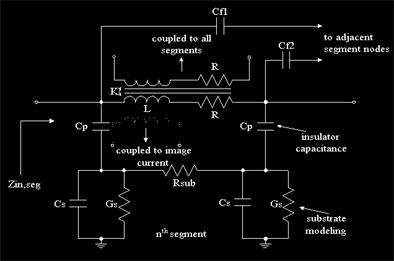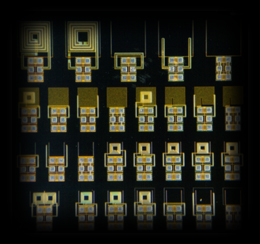|
 The core algorithm of SISP, analytically presented in [1], extracts a two-port network consisting of eleven lumped elements for every segment of the inductor. The main elements of the two-port are the series inductance, the resistance of the segment and the capacitors formed by the insulating SiO2 between the inductor and the Si substrate. The algorithm also calculates the coupling capacitances between parallel adjacent segments and the RC networks for the modeling of the substrate layers under the insulator. The mutual inductance between the segments of the spiral is modeled with a transformer. The equivalent circuit of the spiral inductor includes a transformer for every possible couple of segments. The feature that enhances the accuracy of the inductor model, above the first resonance frequency, is the utilization of a full capacitance matrix. The matrix contains a capacitor not only between adjacent segments but also for every possible pair of segments of the inductor.. The core algorithm of SISP, analytically presented in [1], extracts a two-port network consisting of eleven lumped elements for every segment of the inductor. The main elements of the two-port are the series inductance, the resistance of the segment and the capacitors formed by the insulating SiO2 between the inductor and the Si substrate. The algorithm also calculates the coupling capacitances between parallel adjacent segments and the RC networks for the modeling of the substrate layers under the insulator. The mutual inductance between the segments of the spiral is modeled with a transformer. The equivalent circuit of the spiral inductor includes a transformer for every possible couple of segments. The feature that enhances the accuracy of the inductor model, above the first resonance frequency, is the utilization of a full capacitance matrix. The matrix contains a capacitor not only between adjacent segments but also for every possible pair of segments of the inductor..
A big research effort has been put on the design of on-chip inductors.
A lot of inductor structures have been fabricated and extensively measured to verify the accuracy of SISP. Among the different structures tested there are: square and octagonal inductors, multi-layer inductors and transformers, baluns, splitters and other structures that verify the accuracy in the prediction of the coupling that is made by SISP. |
